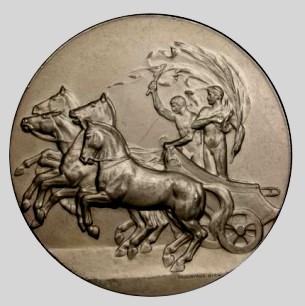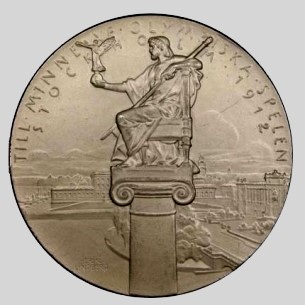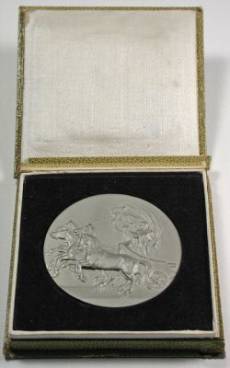Participation Medal


| Material: | Gold | Weight: | ? gr |
|---|---|---|---|
| Material: | Silver | Weight: | 53 gr |
| Material: | Bronze | Weight: | 55 gr |
| Version: | Pewter | Weight: | 45 gr |
| Diameter: | 51 mm | Design by: | Bertram Mackennal |
| Thickness: | 5 mm | Mint: | Vaughton, England |
| Obverse: | Quadriga with triumphant winner. | ||
| Reverse: | Zeus seated on Ionian column holding figure of Nike, Stockholm in back. | ||
| The Commemoration Medal 1912
In May, 1910, the Swedish Olympic Committee
determined to issue a commemoration medal to be presented to the functionaries
and competitors taking part in the Games, and resolved that the obverse
of this medal should be the same as that of the Commemoration Medal of
the London Games. After the Medal and Badge Committee had sent in several
designs for the reverse, drawn by Mr. E. Lindberg, the Swedish Olympic
Committee, at a meeting on the 20 February, 1911, settled the definite
appearance of the medal in question. The Obverse, the permanent side, represents
an classic Greek chariot drawn by four horses, in which stands two male
figures, one the charioteer and the other the judge, ready to present the
triumphant athlete with the palm of victory; the Reverse shows, on the
capital of an Ionian column, Zeus, sitting in a chair of ancient form,
and holding a figure of the Goddess of Victory in his hand. In the background
can be seen the outlines of the Royal Palace of Stockholm, together with
those of Helgeandsholmen Island and of the façade of the Riksdag
House.  Regarding the distribution of the Commemoration
Medal, of which 2 copies were made in gold, 50 in silver, 100 in bronze,
and about 6,000 in oxidized and ordinary pewter, the Swedish Olympic Committee
determined that the Commemoration Medal in gold should be presented to
H. M. King Gustavus and to H. R. H. the Crown Prince of Sweden; in silver,
to the members of the Swedish Olympic Committee and the International Olympic
Committee; in bronze, to the Presidents of the Special Committees and to
the Chairmen of the International Juries; in oxidized and ordinary pewter,
to the other functionaries; to all the competitors that started in any
event; to the staffs of all the offices of the Swedish Olympic Committee,
and, finally, to all those persons, both at home and abroad, who had laboured
for, and helped to further, the success of the Games. (Sourse document: Official Report 1912, page 161) |